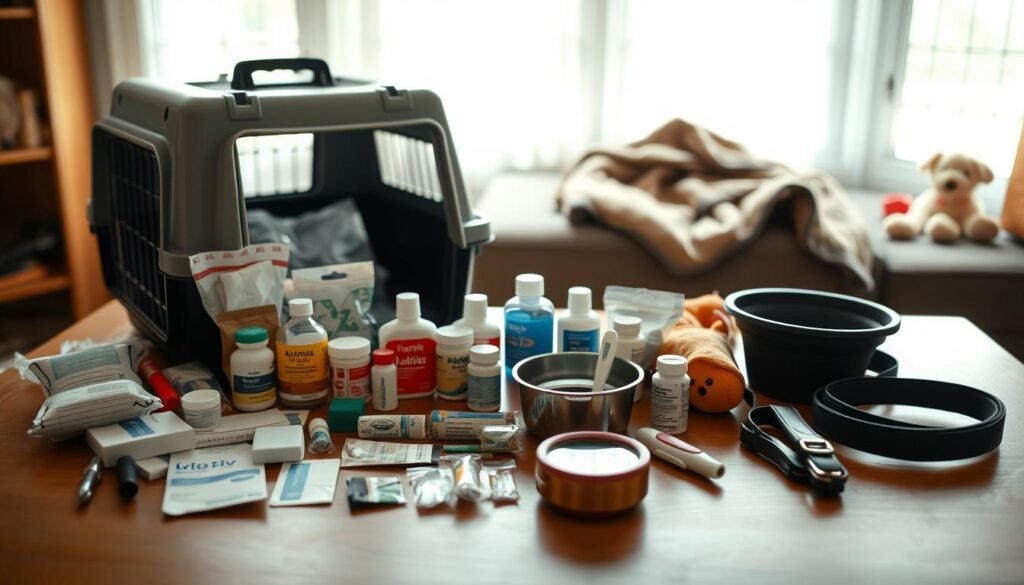When severe weather strikes, does your family have a plan for protecting their furry members? Storms can be terrifying for animals, triggering anxiety, confusion, and even dangerous behavior. Preparing ahead ensures their safety and reduces stress for everyone.
From sudden evacuations to loud thunderclaps, risks multiply quickly. FEMA reports that many pets get lost or injured due to lack of preparation. This guide covers expert-backed strategies for dogs, cats, and larger animals before, during, and after extreme weather.
Key Takeaways
- Storms cause high stress and potential hazards for pets.
- Preparation includes evacuation plans and emergency kits.
- Noise anxiety requires calming techniques.
- Post-storm dangers like debris need attention.
- Expert guidelines improve outcomes for all animals.
Pre-Storm Preparation: Safeguarding Your Pet
Severe weather demands proactive measures for animal companions. Advance planning reduces risks and ensures their well-being when disasters strike. Focus on three pillars: evacuation routes, essential supplies, and reliable identification.

Create an Evacuation Plan
Identify pet-friendly shelters using FEMA’s locator tool. Many hotels accept animals during crises—research options nearby. Designate a buddy system with neighbors for mutual support if you’re away.
Pack a go-bag with leashes, carriers, and vet records. Practice evacuation drills to minimize panic. Emergency plans should include alternate routes in case roads are blocked.
Build a Pet Emergency Kit
Stock 3+ days of food, water, and medications in waterproof containers. Include a first aid kit with vet-approved supplies. Comfort items like toys or anxiety wraps ease stress.
Store copies of vaccination records digitally and physically. Sanitation supplies (litter, waste bags) prevent hygiene issues. Rotate perishables every six months to ensure freshness.
Ensure Proper Identification
76% of lost pets without ID never return home, per ASPCA. Microchipped animals have a 52% higher reunion rate. Update registry details annually with current contact information.
Use GPS collars for real-time tracking. Reflective gear improves visibility in low-light conditions. Tag collars with a secondary phone number for backup.
How to Keep a Pet Safe During a Storm: Immediate Actions
Fast decisions matter when severe weather approaches. Pets need protection from loud sounds and flying debris. Start by moving them inside long before the storm hits.

Bring Pets Indoors Early
68% of storm-related injuries happen to animals left outside. Move dogs, cats, and other companions inside at least six hours before landfall. Close windows to muffle thunder noises.
Create a checklist for last-minute tasks. Charge phones and pack a backup battery. Make sure emergency contact details are updated in case of separation.
Secure a Safe Space
Designate a quiet room with an escape-proof crate or carrier. Line it with familiar bedding to ease anxiety. Heavy curtains or acoustic panels help dampen scary sounds.
White noise machines cut canine stress by 40%. For extra security, use the “two-leash rule” during evacuations. Always have a backup shelter plan ready.
Monitor Weather Updates
Bookmark NOAA Weather Radio channels for live alerts. The FEMA app tracks storms in five locations simultaneously. Pre-load pet medical profiles into emergency apps.
Place pet cameras with two-way audio in their safe place. This lets you check on them remotely. Stay informed to act fast if conditions worsen.
Calming Your Pet During a Storm
Loud thunder and flashing lights can send pets into panic mode. Recognizing their fear helps you act swiftly. Simple strategies like distractions, calming tools, and your own composure make a big difference.
Use Distractions and Comfort Items
Classical music reduces canine heart rates by 18% during storms. Play soft melodies to mask scary sounds. Treat-dispensing puzzles keep pets engaged with high-value rewards.
Lavender diffusers leverage smell therapy for relaxation. Pair these with familiar blankets or toys. The combo of sensory distractions cuts anxiety triggers effectively.
Try Calming Remedies
Thundershirts work for 80% of mild anxiety cases by applying gentle pressure. Adaptil pheromone diffusers lower stress behaviors by 67%.
For severe cases, consult your vet about Trazodone. Always test remedies before storms hit. CBD treats (with vet approval) offer another option.
Maintain a Calm Demeanor
Pets mirror owner emotions. Practice slow breathing to reduce stress for both of you. Avoid coddling—it can reinforce fearful behavior.
Use TTouch massage techniques to soothe nerves. Stay near their safe space without crowding them. Your steady presence matters most.
Post-Storm Safety and Recovery
After the storm passes, dangers still linger for your furry companions. Floodwater, debris, and displaced wildlife pose new threats. A careful recovery plan protects both pets and home.
Inspect Your Home and Yard
Check for downed power lines or broken glass. Use a leash to control dogs while surveying damage. Floodwater contains 40x more pathogens—block access to contaminated areas.
Set up a paw-washing station with clean water. This removes toxic debris. Store food in sealed containers to prevent spoilage.
Check for Wildlife Hazards
Post-storm wildlife encounters spike by 300%. Motion-activated lights deter raccoons or snakes. Keep animals indoors until hazards are cleared.
Leptospirosis vaccines are critical after floods. Schedule a vet visit if your pet waded through standing water.
Reunite Lost Pets
62% of displaced pets are found within one mile. Post QR-coded flyers with contact information at local shelters. Nextdoor alerts boost reunion chances.
Carry a bag with treats and a spare leash during searches. Stress can alter a pet’s smell, making recognition harder.
Conclusion
Storms test every pet owner’s readiness—are you prepared? A three-phase strategy (Prepare, Protect, Recover) ensures pet safety and strengthens the family bond during crises.
Download FEMA’s emergency plan templates and bookmark pet disaster hotlines. Refresh kits every six months to stay ready.
Microchipping and updated IDs reduce stress if separation occurs. Your calm actions turn chaos into security for furry loved ones.
FAQ
What should be included in a pet emergency kit?
A well-stocked kit should have food, water, medications, vet records, a leash, waste bags, and comfort items like toys or blankets. Include contact information for shelters and veterinarians.
How can I reduce my dog’s anxiety during thunderstorms?
Create a quiet space with familiar smells, use white noise to mask thunder, and offer treats or toys for distraction. Calming wraps or pheromone sprays may also help.
Should I crate my pet during a storm?
If your pet feels secure in a crate, it can provide safety. Ensure the carrier is sturdy, well-ventilated, and lined with soft bedding to minimize stress.
What if my pet gets lost during severe weather?
Microchipping and updated ID tags improve recovery chances. Post on local social media groups and contact nearby shelters immediately.
Are hotels pet-friendly during evacuations?
Many hotels accept animals in emergencies. Check pet policies in advance and keep a list of approved locations in your emergency plan.
How do I protect my pet from post-storm hazards?
Inspect your yard for debris, standing water, or displaced wildlife. Keep dogs leashed until the area is confirmed safe.



